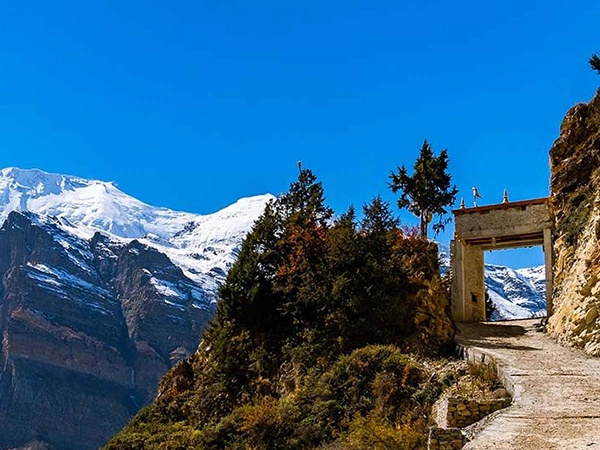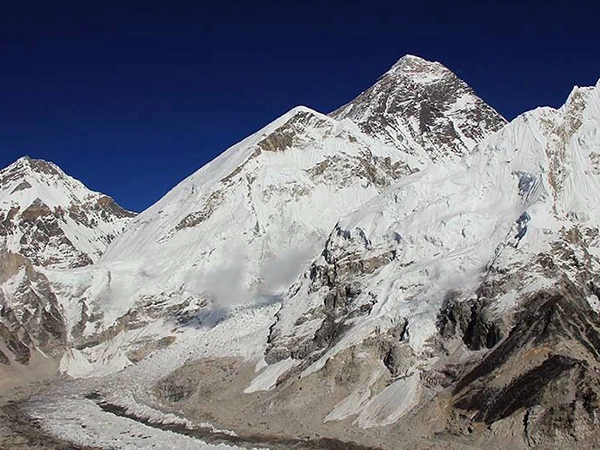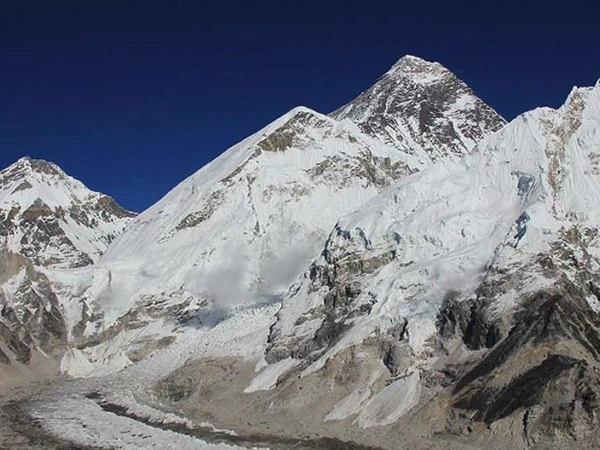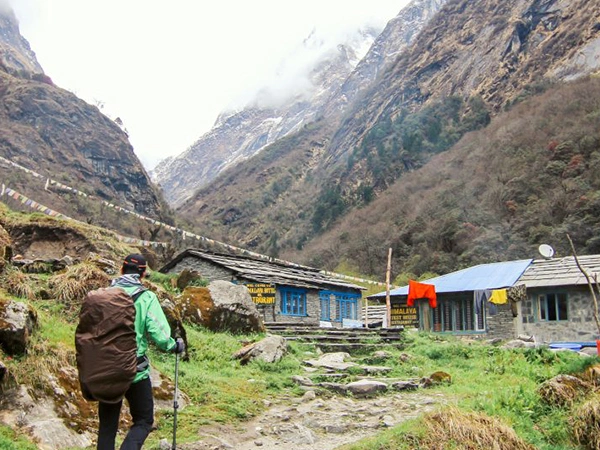Annapurna region, the western part of Nepal, is one of the most popular destinations when it comes to Himalayan adventure activities. Home to the tenth-highest alpine peak in the world, Mt. Annapurna (8,091 meters), the Annapurna Circuit Trek and Annapurna Base Camp Trek are two of the incredible trekking prospects in the region to admire the beauty of this pristine peak and surrounding regions. But, besides the natural factors, the cultural experience on this trail is also top-class, and the trekking adventures here are renowned across the world for the cultural exhilarating journey. Considering the unparalleled experiences, this circumnavigating journey is undoubtedly one of the most remarkable treks in the Himalayas, but how difficult is the Annapurna Circuit Trek exactly?
Well, to put it in simple words, the 8 Days Annapurna Circuit Trek is considered one of the milder forms of the Himalayan journey. Trekkers don’t have to test their skills on the technical section and the trails aren’t strenuous like mountain expeditions. Nonetheless, this is still a thrilling Himalayan journey that includes traversing across one of th highest passes in Nepal. So, there are several difficult factors that you have to understand and consider if you want to ensure an unforgettable memory. Let’s check out some of the major aspects of this circuit route that you have to be mindful of during your Himalayan journey.
Physical Demands
Required Fitness Level
Understanding the physical demands of the trail will help you to have a proper grasp of how difficult is the Annapurna Circuit Trek. This circular journey of the tenth-highest mountain in the world has been graded as a moderately difficult trek. There aren’t technical sections along the way, and the day-to-day treks are physically strenuous. Thus, the recommended fitness level for this trek is at least basic. It is not a secret that a better level of fitness, the more easier ti will be to overcome the challenges and enjoy the journey.
However, even if you are not in top shape, just basic fitness with good health will be enough for this trek. If you train within the recommended frame for the trek, even if you have basic fitness, you will find it much easier to complete the trek.
Typical Daily Distances and Elevation Gain
The overall trekking route of the Annapurna Circuit Trek is approximately 208 km (129 miles). Thus, during the standard 11 to 13 days of trekking itinerary plan, you will have to cover a trekking distance of approximately 5 to 6 hours per day. It is not easy to traverse the demanding trails covering such long hours of trek without proper physical preparation. Similarly, during the Annapurna Circuit Trek, you will get started on the trekking trail from Dharapani (1,960 meters).
You will gradually follow the winding-up trail, crossing high elevation points like Chame (2,710 meters), Pisang (3,300 meters), Manang (3,500 meters), Yak Kharka (4,110 meters), Thorong Phedi (4,420 meters) and reach the highest point at Thorong La Pass (5,416 meters). The total altitude gain on this trekking trail is about 3,456 meters (11,338 feet) before you descend to Muktinath (3,800 meters) for a drive down to Pokhara (822 meters) via Jomsom Bazaar (2,743 meters).
Common Physical Challenges
During this Annapurna Circuit Trek, you will follow the trail across significant altitudes and move along the physically demanding trails. When gradually start climbing to a higher altitude, even basic physical activities start to get really draining. So, carrying a backpack climbing to such altitudes with lower oxygen saturation levels can be really demanding if you are not prepared for it.
Similarly, the mountain region in Nepal is known for remoteness; it is nothing like the flat land of the Terai or the relatively easy inclines of the hilly regions. During this circuit trek, you will have to overcome the steep dropping and ascending section on uneven ground. The journey can be especially draining during the long hike parts, such as crossing the Thorong La Pass; the trekking part of this section will last about 7 to 8 hours.
Altitude Considerations
Altitude Profile of the Trek
The altitude gain of this circumnavigating Himalayan adventure is another major factor of the Annapurna Circuit difficulty. During this trek, you will get to the maximum point of 5,416 meters (17,769 feet) at Thorong La Pass, which is one of the major Himalayan passes in Nepal. As the trek starts from Dharapani, which is at an elevation of 1,960 meters (6,430 meters), the overall altitude gain in this trek is 3,456 meters (11,338 feet). So, the Annapurna Circuit Trek has been labeled as one of the incredible journeys in the Himalayas with significant altitudes.
Unlike the other Himalayan treks that have mild altitude gain, in this mainstream trek, you will have to traverse across the significant points above 4,000 meters and reach the maximum point in the trans-Himalayan zone (above 5,000 meters). So, despite its moderate difficulty nature, this trek shouldn’t be taken lightly as the looming risk of altitude sickness is real if a proper acclimatization process isn’t followed.
Risks of Altitude Sickness
Generally, there is a risk of altitude sickness for humans after crossing an altitude of over 3,000 meters (9,842 feet). Although it is a standard margin, the capability of adapting to the new altitudes depends on at what elevation points the person lives. You might have heard about the superhuman Sherpa people who can even climb mountains without oxygen. So, the risk depends on the adaptability of person to person.
Normally, for exploring the higher regions, it is recommended that explorers should aim to cross for more than 500 meters altitude in a single day and should take an acclimatization day after crossing gaining 1,000 meters in altitude. This helps the body to properly adapt to the new altitudes without the need to take risks. As this circuit trekking trail doesn’t ascend to the alpine slopes, Acute Mountain Sickness (AMS), which is the milder form of altitude sickness, is the only risk here. If it were a mountain expedition, there would also be risks for the more severe forms of altitude sickness like High Altitude Pulmonary Edema (HAPE) and High Altitude Cerebral Edema (HACE).
Acclimatization Tips and Strategies
The risk of the milder form of altitude sickness, Acute Mountain Sickness (AMS), is not that hard to deal with. If you follow the proper acclimatization process, you won’t have to suffer from even the mild symptoms of this mountain sickness like headache, insomnia, dizziness, nausea, loss of appetite, fatigue, shortness of breath, etc. Himalayas On Foot has designed a standard 11 Days Annapurna Circuit Trek with strategic distance coverage and altitude gain, so you can acclimatize as you trek. Also, you will get an acclimatization day to let your body get the much-deserved rest.
So, as we have got the acclimatization part covered, here are some other effective tips that will help you keep the risk of altitude sickness at bay:
Tips to Migitate Risks of Altitude Sickness During Annapurna Circuit Trek
- Hydration is the key when it comes to avoiding altitude sickness (drink at least 3 to 4 liters of water per day)
- Eat a balanced diet; don’t go for packed food or taste
- It is normal to feel the loss of appetite at higher altitudes, but don’t skip meals
- Don’t climb too fast while ascending to the higher altitudes
- Trek slowly and take short refreshment breaks along the trail
- Monitor your health and pay attention to symptoms of altitude sickness
- It will be wise to pack altitude sickness medication during your Himalayan journey
- Weather and Seasonal Factors
Best Time of Year to Trek
To make the best out of this journey and avoid dealing with unnecessary Annapurna Circuit Trek difficulty factors, you should consider doing this trek during one of the peak seasons. Spring (March to May) and autumn (September to November) are top contenders when it comes to pleasant explorations in the Himalayas. These seasons ensure the best experience, and you move along the trekking trails feeling comfortable. If you trek in any of these seasons, you also won’t have to deal with the unfavorable weather phenomenon that can elevate the overall Annapurna Circuit Trek difficulty even further.
The spring is famous for its stunning natural wonders; during this season, the country’s landscape is covered with stunning visuals as it welcomes the peak period of nature. Similarly, the temperatures are pleasant, the trails are comfortable, the Himalayan flora and fauna are at their peak, and the mountain views are just epic. The autumn season, which is known for its most stable climate, is also on par with the spring season when it comes to gratifying Annapurna Circuit Trekking experience. The dry and well-maintained trade, wide visibility of the Himalayan vistas, cool and fresh temperatures, and vibrant cultural experience make the journey really magical.
Weather Patterns and Climate
The four seasons of nature welcome different climatic conditions and environments in the Himalayas. During the high seasons like spring and autumn (considered to be best for mountaineering and trekking in the Himalayas), the weather is most stable. The trekking days are accompanied by sunny, warm days, and the sky is mostly clear. However, as the higher Himalayan region has a climatic zone of its zones, this predictability factor is most accurate in the lower regions only. At the higher region the change in climate can be sudden and unpredictable. The climate prediction can be even more unreliable at the high altitudes during the low-seasons like winter (December to February) and monsoon (June to August).
The winter season receives snowfall in the higher regions, and the temperatures are freezing even during the day. As for the monsoon, it has the most unpredictable weather among other seasons. Although after rain, the atmosphere is fresh and cool, and during the clear days, the mountain views are epic, the unpredictability in the weather affects the overall plans of the trek.
Impact of Seasonal Changes on Trekking Conditions
Trekking during the high/ peak season guarantees an incredible experience. So, if you plan on doing this trek during either autumn or spring, you will not have to deal with the weather challenge factors of the Annapurna Circuit Trekking difficulty. However, if you are doing this trek during monsoon or winter, then it is a completely different story. Both of these seasons are considered to be low periods for outdoor explorations in the country. The winter season is the coldest period in the country, and the temperatures drop to minus degrees in the Himalayan region.
If you want to explore the Annapurna Circuit route during this season, you will have to deal with several winter-season phenomena like winter blizzards, high winds, deep snow, and slipper icy trails that can make the journey challenging. The acclimatization process is also considered to be much more difficult during this season. As for the monsoon, it has the most unfavorable climate. The continuous downpour that invites natural calamities like flooding and landslides is known to affect the overall itinerary plans and disrupt the modes of transport. Similarly, the slippery and muddy trails make it hard to move along the high-altitude trails, and if you are not careful with footing, it can even put your life at risk.
So, to ensure the best experience during your trek, you should definitely take part in this Annapurna massif circumnavigating journey in one of the peak seasons.
Health and Safety
Common Health Issues
One of the factors that contribute to the Annapurna Circuit Trek difficulty is the common health issues during the trek. As you will be navigating your way across diverse climatic zones in this circuit, there is a chance that you might face some minor health issues. As there are limited health facilities along the trekking trail, if you face any major illness during the trek, you will have limited options to choose from. You can either halt your journey and rest or descend down to lower altitudes with better facilities.
However, if the case is somewhat serious, then helicopter rescue that takes you to a hospital in major cities like Pokhara or Kathmandu is the only viable option. Thats why it is important to take care of your health, hygiene, and sanitization on the mountain so you don’t have to face any kind of inconvenience. It is recommended that you bring a small first aid kit with general medications. If you are on a prescribed medication, you will need a sufficient amount of those medicines as it is not possible to restock them on the mountain.
Safety Precautions and Tips
- Understand your body’s limit, and don’t push yourself too hard
- Eat nutrient-rich food so your immune system doesn’t degrade during the long Himalayan journey
- Strictly follow the personal hygiene and sanitization protocols
- Don’t underestimate altitude sickness, as it immensely affects your immune system
- Get enough rest and sleep, and don’t over-exhaust yourself
- Carry a first-aid box with basic medication and your personal medication, if any
- Don’t drink water directly use a filtration system and water purifier
- Don’t consume meat items in the higher regions as they are mostly stocked for long periods due to remoteness
- Carry bug protection (spray or cream) to avoid any kind of bite that could lead to infection
- Keep yourself warm in the higher region as it is generally cold
Safety and Comfort Trekking While With the Himalayas On Foot
While doing the 11 Days Annapurna Circuit Trek we will take care of everything so you can stay assured during your exploration. The safety and comfort of our guests is the foremost priority of the Himalayas On Foot. Your trek will be led by an exceptional mountain guide with significant years of experience guiding the Annapurna Circuit Trek route. Besides the logistic details of your journey, your guide will also be responsible for your safety, health, and comfort. The trekking crew will check your health conditions during each day of the trek and see how well you are doing both mentally and physically in the trek.
We will also provide an extensive first-aid medical kit to the trekking group. Our guides, who have received first aid and high altitude training, will provide immediate assistance in case of any unforeseen circumstances. In case the issue is serious, your guide will then coordinate with our head office to take necessary actions. So, you are in safe hands for your exciting Himalayan journey, leaving everything to us, and just enjoy this exciting Himalayan trek.
You may also like:
Logistical Challenges
Access to Start and End Points
If you are managing the trek on your own, there are also several logistic challenges of the trek that you have to account for. First of all, you have to be adequately familiar with the region so you can decide on the starting point and ending point of the trek. This is very important as the permits are provided based on these points and overall itinerary plans. You will need permits like Annapurna Conservation Area Permit (ACAP) and TIMS Card to access the protected areas in the region.
Doing paperwork for the trek, collecting permits, deciding overall itinerary plans, and setting start and end dates and locations can be quite burdensome if you don’t have proper trekking experience. As traversing across the high altitude regions is a challenging endeavor that also has several risk factors, you are required to do this trek with either a licensed agency or a licensed guide.
Availability of Accommodation and Food
One of the important parts of any long journey is securing food and accommodation to let the body get enough rest and replenish the lost energy. However, handling the logistics for this factor can be a challenge if you are not familiar with the resting stops along the trail. Also, during the peak season, due to the flow of a large number of trekkers, pre-booking is an absolute necessity.
Normally, guides handle these factors, and while trekking through an agency, it is much more easier to book for the services. As the guides have familiarity with the owner of the teahouses, the coordination for meal preference, placing orders, service upgrades, etc are more efficient. So, instead of checking out the availability of accommodation and food on the trekking trail, you will feel at ease while trekking with an agency that pre-books everything for the complete itinerary plan.
Mental and Emotional Challenges
Psychological Demands of Long-distance Trekking
If this is your first time doing an extensive high-altitude journey, you also have to consider the psychological demands of the trails besides the physical. During the Annapurna Circuit Trek, you will ascend to high-elevation points and walk a significant distance during each day’s trek. The Himalayan region in Nepal is an isolated part of the country that is behind in infrastructural and technological development.
Thus, it will be folly to expect a high level of services during your Himalayan journey and compare it to the services provided by an urban vacation destination. You will have to prepare yourself for the inconveniences and discomfort that you might have to face during the trek. In our 11 Days Annapurna Circuit Trek, you will spend 8 nights on the mountain at the teahouses run by natives. So, it is important to mentally prepare yourself for the isolation from urban settlements as you head toward the heart of the Himalayas.
Coping Challenges and Fatigue
Focussing just on the physical preparation is never enough for the long journey that tests mental fortitude as well. So, to overcome the Annapurna Circuit Trek difficulty, you will also need to mentally prepare for the challenges that come along with this Himalayan journey. Although this trek has been labeled as a moderately difficult adventure, to overcome the challenges and physical exhaustion that you have to face during your day-to-day adventure, you will need a good amount of willpower.
You might have heard about the trekkers in their 70s and even children successfully completing this high-altitude trek. Yes, physical preparation is absolutely necessary, but determination and motivation also serve to great lengths to overcome the inconveniences and challenges along the trail. It is normal to face obstacles during remote exploration like; it is upto your attitude and reaction to the situation to determine what comes out of this journey.
Strategies for Mental Preparation
In order to stay motivated and positive even when you run into any kind of obstacles and inconveniences during your trek, you can follow the following tips.
- Don’t set unrealistic expectations; remember it is a remote journey to the Himalayas, and setting too high a bar can leave you feeling disappointed
- Learn to leave your comfort zone this will help you to cope with the minor inconvenience that you might face during your Himalayan journey
- Visualize helps a lot; try visualizing your journey, the demands of the trail, and the challenges that you might have to face
- Practice meditation and focused breathing to stay calm and composed no matter what kind of situation is
- Build your confidence and coping strategies
- Set realistic goals, and don’t push yourself too much
- Surround yourself with positive people and keep positive thoughts in mind instead of straying to the negative aspects
- Understand the support system in the team; this will help you travel with ease and assuredly
Training and Preparation
After understanding the mental and emotional challenges of the Annapurna Circuit Trek difficulty, let’s move on to the physical preparation part. This is the most crucial part of your preparation that determines the overall comfort level during the actual trek. For the high altitude trek like Annapurna Circuit with long trekking distances each day, you should focus on improving your overall physical prospects to ensure a comfortable experience. You should start your preparation first with a proper physical assessment; this will help you determine your fitness level, your strong points, and your weak points. Your guide will recommend you train for around 3 to 6 weeks for the trek.
However, you can freely adjust the training timeframe depending on your overall fitness level. If you are not that physically active, you should consider extending the training period. Just setting aside a few hours from your daily schedule will be enough to make up for the physical requirement of this iconic Himalayan journey. Your strength level will come into play as it determines how well you will be along the remote and steep trails of the Himalayas carrying your backpack. So, you should include strength and endurance-enhancing exercises during your training for legs, arms, shoulders, back, etc. Also, stamina exercises are very helpful for long hours of trek and they are also known to make the acclimatization process easy. So, make sure to include them in your training as well.
**Note: If you have a proper hiking location, you should do some practice hikes to understand your physical capabilities and the terrains you have to overcome during your trek. This will also give you a chance to test the quality and capabilities of your trekking gear**





![Best Time to Do the Tsum Valley Trek in Nepal [With Trekking Tips]](https://himalayasonfoot.com/uploads/blog/best-time-to-do-the-tsum-valley-trek-in-nepal.webp)
